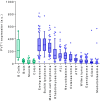Long Non-coding RNA PVT1 as a Prognostic and Therapeutic Target in Pediatric Cancer
- PMID: 31781490
- PMCID: PMC6853055
- DOI: 10.3389/fonc.2019.01173
Long Non-coding RNA PVT1 as a Prognostic and Therapeutic Target in Pediatric Cancer
Abstract
In recent decades, biomedical research has focused on understanding the functionality of the human translated genome, which represents a minor part of all genetic information transcribed from the human genome. However, researchers have become aware of the importance of non-coding RNA species that constitute the vast majority of the transcriptome. In addition to their crucial role in tissue development and homeostasis, mounting evidence shows non-coding RNA to be deregulated and functionally contributing to the development and progression of different types of human disease including cancer both in adults and children. Small non-coding RNAs (i.e., microRNA) are in the vanguard of clinical research which revealed that RNA could be used as disease biomarkers or new therapeutic targets. Furthermore, many more expectations have been raised for long non-coding RNAs, by far the largest fraction of non-coding transcripts, and still fewer findings have been translated into clinical applications. In this review, we center on PVT1, a large and complex long non-coding RNA that usually confers oncogenic properties on different tumor types. We focus on the compilation of early advances in the field of pediatric tumors which often lags behind clinical improvements in adult tumors, and provide a rationale to continue studying PVT1 as a possible functional contributor to pediatric malignancies and as a potential prognostic marker or therapeutic target.
Keywords: 8q32; PVT1; epigenetic; lncRNA; pediatric cancer.
Copyright © 2019 Boloix, Masanas, Jiménez, Antonelli, Soriano, Roma, Sánchez de Toledo, Gallego and Segura.
Figures



Similar articles
-
PVT1 Long Non-coding RNA in Gastrointestinal Cancer.Front Oncol. 2020 Jan 31;10:38. doi: 10.3389/fonc.2020.00038. eCollection 2020. Front Oncol. 2020. PMID: 32083000 Free PMC article. Review.
-
Long non-coding RNA PVT1 and cancer.Biochem Biophys Res Commun. 2016 Feb 26;471(1):10-4. doi: 10.1016/j.bbrc.2015.12.101. Epub 2016 Feb 3. Biochem Biophys Res Commun. 2016. PMID: 26850852 Review.
-
Regulatory Mechanisms and Clinical Applications of the Long Non-coding RNA PVT1 in Cancer Treatment.Front Oncol. 2019 Aug 21;9:787. doi: 10.3389/fonc.2019.00787. eCollection 2019. Front Oncol. 2019. PMID: 31497532 Free PMC article. Review.
-
The expression pattern of long non-coding RNA PVT1 in tumor tissues and in extracellular vesicles of colorectal cancer correlates with cancer progression.Tumour Biol. 2017 Apr;39(4):1010428317699122. doi: 10.1177/1010428317699122. Tumour Biol. 2017. PMID: 28381186
-
Knockdown of long non-coding RNA PVT1 induces apoptosis and cell cycle arrest in clear cell renal cell carcinoma through the epidermal growth factor receptor pathway.Oncol Lett. 2018 May;15(5):7855-7863. doi: 10.3892/ol.2018.8315. Epub 2018 Mar 21. Oncol Lett. 2018. PMID: 29725475 Free PMC article.
Cited by
-
Novel Insights into the Emerging Role of Neat1 and Its Effects Downstream in the Regulation of Inflammation.J Inflamm Res. 2022 Jan 26;15:557-571. doi: 10.2147/JIR.S338162. eCollection 2022. J Inflamm Res. 2022. PMID: 35115805 Free PMC article. Review.
-
Long non-coding RNA PVT1: A promising chemotherapy and radiotherapy sensitizer.Front Oncol. 2022 Jul 29;12:959208. doi: 10.3389/fonc.2022.959208. eCollection 2022. Front Oncol. 2022. PMID: 35965522 Free PMC article. Review.
-
Precise engineering of Gemcitabine prodrug cocktails into single polymeric nanoparticles delivery for metastatic thyroid cancer cells.Drug Deliv. 2020 Dec;27(1):1063-1072. doi: 10.1080/10717544.2020.1790693. Drug Deliv. 2020. PMID: 32672077 Free PMC article.
-
LncRNA PVT1 accelerates malignant phenotypes of bladder cancer cells by modulating miR-194-5p/BCLAF1 axis as a ceRNA.Aging (Albany NY). 2020 Nov 16;12(21):22291-22312. doi: 10.18632/aging.202203. Epub 2020 Nov 16. Aging (Albany NY). 2020. PMID: 33188158 Free PMC article.
-
Role of autophagy‑modulating long non‑coding RNAs in tumor radioresistance (Review).Oncol Rep. 2025 Nov;54(5):142. doi: 10.3892/or.2025.8975. Epub 2025 Aug 24. Oncol Rep. 2025. PMID: 40849822 Free PMC article. Review.
References
-
- Roma J, Almazán-Moga A, Sánchez de Toledo J, Gallego S. SMF. miRNAQ16 targeted therapies in the most prevalent pediatric solid tumors. In: International S, editor. MicroRNA Targeted Cancer Therapy. Springer International Publishing; (2014). p. 239–63. 10.1007/978-3-319-05134-5_14 - DOI
Publication types
LinkOut - more resources
Full Text Sources

